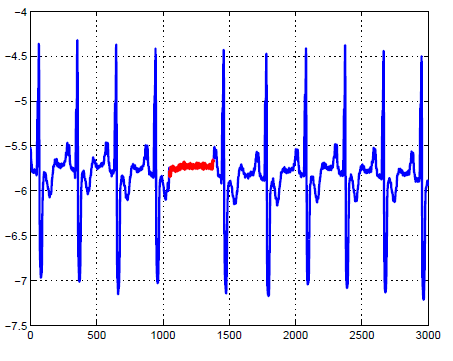Anomaly Detection for
Time Series
Yung-Sheng Lu
Apr 11, 2017
@NCKU-CSIE
Outline
-
Problem Setting
-
Challenges
-
Types of Time Series
-
Existing Techniques
-
Transformation of Data
-
Detection Techniques
-
Discord Detection
Problem Setting
Problem Setting
-
Detecting contextual anomalies in the time series
The anomalies are the individual instances of the time series which are anomalous in a specific context, but not otherwise.

Problem Setting (cont.)
-
Detecting anomalous subsequence within a given series
Find an anomalous subsequence with respect to a given long sequence (time series).

discords
Problem Setting (cont.)
-
Detecting anomalous time series base on a time series data base
- Determine if a test time series is anomalous with respect to a database of training time series.
- This database can be of two types.
-
Only normal time series
- semi-supervised setting
-
Both normal and anomalous data
- unsupervised anomaly detection
-
Only normal time series
Challenges
Challenges
- Many ways in which an anomaly occurring in a time series may be defined.
- For detecting anomalous subsequences, the exact length of the subsequence is often unknown.
- The training and test time series can be of different lengths.
- Best similarity/distance measures which can be used for different types of time series is not easy to determine.
Challenges (cont.)
- Performances of many anomaly detection algorithms are highly susceptible to noise in the time series data, since it is hard to differentiating anomalies from noise.
- Time series in real applications are usually long and as the length increases the computational complexity also increases.
- Many anomaly detection algorithms expect multiple time series to be at a comparable scale in magnitude while for most of the data it is not true.
Types of Time Series
Types of Time Series
- In most of the techniques in this survey
- Training data to learn a model for normal behavior
-
Test data is assigned an anomaly score based on the model.
-
Two key characteristics of time series
- periodicity
- synchronous
Types of Time Series (cont.)
- Periodic and Synchronous

Types of Time Series (cont.)
- Aperiodic and Synchronous

Types of Time Series (cont.)
- Periodic and Asynchronous

Types of Time Series (cont.)
- Aperiodic and Asynchronous

Existing Techniques
Overview
-
Anomaly detection techniques can be classified
-
Procedural dimension
the process of finding anomalies -
Transformation dimension
the data is transformed prior to anomaly detection.
-
Procedural dimension
- Both these dimensions are orthogonal.

Overview (cont.)
-
Window-based and similarity-based methods
Build a lazy learning model which compares the test time series with the given training time series for assigning anomaly scores.
-
HMM-based and Regression-based methods
Build parametric models on the training data which probabilistically assign anomaly scores to a test time series.
-
Segmentation-based methods
Build a finite state automaton on the given training data and predict the state of the test time series.
Overview (cont.)
-
Aggregation-based transformation
Focus on dimensionality reduction by aggregating consecutive values.
-
Discretization-based and Signal-processing-based transformations
Reduce the dimensionality of the data in different ways and transform the input data into a different domain which can be used to obtain computational efficiency.
Transformation of Data
Motivation
-
Exist many challenges associated with handling time series.
- high-dimensionality, noise, scaling etc.
- To achieve computational efficiency.
Before Start
-
Many anomaly detection algorithms expect multiple time series to be at a comparable scale.
-
Normalize the data
Each attribute contributes uniformly for the similarity.
-
Normalize the data
Aggregation
- Compress a time series by replacing a set of consecutive values by a representative value of them.
- usually use the average
- deals with the time domain of the time series
-
Benefits
- reduces dimensionality of the data
-
the resulting time series is smoother
- masks noise and missing values
Discretization
-
Convert the given time series into a discrete sequence of finite alphabets.
- deals with the amplitude domain of the time series
- cause loss of information
-
Steps
- Divide the amplitude range into different bins
- Assign a symbol to each of the bin
- Transform the time series by replacing every data point
Discretization (cont.)
-
Example
- The time series amplitude (0-3) is divided into 3 equal sized bins and assigned a, b, c.
- The symbolic representation would be bbccabaacc

Signal Processing
- Like Fourier transforms, wavelet transforms help to obtain this entirely different space of coefficients where the data can be analyzed
- used to get a lower dimensional representation of time series
-
Haar Transform
- A sequence of averaging and differencing operations on the consecutive values of a discrete time function.
- Preserves the Euclidean distance between two time series.
Detection Techniques
Overview
-
The process of anomaly detection
- Compute the anomaly scores of individual observations or subsequences of a given test time series using a detection technique.
-
Aggregate these anomaly scores to calculate the anomaly score of the given test time series.
- mean of all the anomaly scores
- mean of top k anomaly scores
- mean of log of anomaly scores
- number of times the running average of the anomaly scores exceeds a threshold
Window-based
- Divide the given time series into fixed size windows (subsequences) to localize the cause of anomaly within one or more windows.
- An anomaly can be caused due to the presence of one or more anomalous subsequences.
Proximity-based
- The pairwise proximity between the test and training time series using an appropriate distance or similarity kernel to compute the anomaly score of the test time series.
- The anomalous time series are different from the normal ones.
- can be captured using a proximity measure.